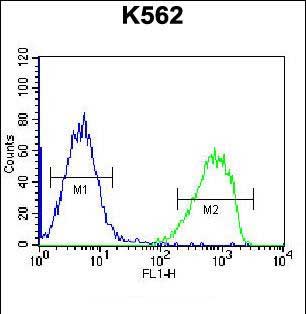

| WB | 1/1000 | Human,Mouse,Rat |
| IF | 咨询技术 | Human,Mouse,Rat |
| IHC | 咨询技术 | Human,Mouse,Rat |
| ICC | 技术咨询 | Human,Mouse,Rat |
| FCM | 1/10-1/50 | Human,Mouse,Rat |
| Elisa | 咨询技术 | Human,Mouse,Rat |
| Aliases | Serine protease inhibitor Kazal-type 8, SPINK8 |
| Entrez GeneID | 646424 |
| WB Predicted band size | 10.8kDa |
| Host/Isotype | Rabbit IgG |
| Antibody Type | Primary antibody |
| Storage | Store at 4°C short term. Aliquot and store at -20°C long term. Avoid freeze/thaw cycles. |
| Species Reactivity | Human |
| Immunogen | This SPINK8 antibody is generated from rabbits immunized with a KLH conjugated synthetic peptide between 63-91 amino acids from the C-terminal region of human SPINK8. |
| Formulation | Purified antibody in PBS with 0.05% sodium azide. |
+ +
SPINK8. a member of the serine protease inhibitor Kazal-type (SPINK) family, is a relatively understudied protein implicated in regulating protease-mediated pathways. It shares structural features with other SPINK proteins, including a conserved N-terminal signal peptide and a Kazal-type inhibitory domain, which enables interaction with target proteases. SPINK8 is primarily expressed in epithelial tissues, particularly the skin and gastrointestinal tract, suggesting roles in maintaining tissue homeostasis and barrier function. Its expression has also been detected in certain cancers, though its pathological relevance remains unclear.
Antibodies targeting SPINK8 serve as critical tools for elucidating its biological functions. They enable detection of SPINK8 in tissue samples via immunohistochemistry and Western blotting, aiding research into its tissue-specific expression patterns. Emerging studies suggest SPINK8 may modulate inflammatory responses and epidermal differentiation by inhibiting specific proteases, such as kallikreins, but mechanistic details are sparse. Commercial SPINK8 antibodies are typically polyclonal or monoclonal, validated for cross-reactivity and specificity across species. Current research focuses on clarifying its role in diseases like atopic dermatitis, psoriasis, and carcinomas, with antibodies facilitating functional assays and biomarker discovery. However, the lack of comprehensive characterization limits clinical translation, underscoring the need for further studies to define SPINK8's therapeutic potential.
×